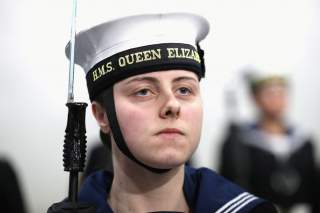Does the United Kingdom Have Enough Money for Its Carriers and Their Escorts?
There's trouble afoot lads.
Key point: London wants to have it all, but it may not have the funds to maintain its navy. In fact, the cost of its carriers will make it harder to build other ships or acquire for jet fighters.
The Royal Navy in late 2019 announced the composition of its first-ever aircraft carrier battle group. And it’s both good and bad news for the storied fleet.
Good news because the Royal Navy just barely should be able to generate all the ships and planes it need to deploy an entirely British battle group.
Bad news because frequent deployments with the same mix of ships clearly is unsustainable as the Royal Navy shrinks, the inevitable result of decades of declining budgets.
HMS Queen Elizabeth, the lead vessel in a two-ship class of conventionally-fueled carriers, is slated to deploy for the first time in 2021. Fleet officials told reporters the flattop will sail with two Type 45 destroyers including HMS Dragon, two Type 23 frigates including HMS Northumberland, a nuclear-powered attack submarine, the tanker RFA Tideforce and fleet stores ship RFA Fort Victoria.
Queen Elizabeth’s air wing for the deployment, which could take the carrier group through the Mediterranean Sea to the Persian Gulf en route to the Pacific Ocean, will include 24 F-35B stealth jump jets, including U.S. Marine Corps aircraft, in addition to helicopters.
That’s a lot of combat power. But it stretches the U.K. armed forces’ capacity. The Royal Navy possesses just six destroyers, 13 frigates and six attack submarines. But usually more than half of those vessels at any given time are in shipyards for repairs or refits.
In deploying with four destroyers and frigates plus a submarine, Queen Elizabeth will leave the United Kingdom with just a handful of surface warships and potentially one attack submarine for other taskings.
Likewise, the flattop’s air wing during that first deployment could require every single deployable British F-35. It’s not for no reason that fleet officials have stressed the U.S. Marine Corps’ willingness to contribute jump jets to the deployment.
“We are constrained by the F-35 buy-rate even though that was accelerated in [the strategic defense review] in 2015, so initial operating capability numbers in 2020 are going to be very modest indeed,” said Capt. Jerry Kyd, Queen Elizabeth’s former skipper. The Royal Air Force was able to generate just seven F-35s for trials aboard the carrier in late 2019.
“We will flesh it out with helicopters, and a lot depends on how many USMC F-35s come on our first deployment in 2021,” Kyd said. “But by 2023, we are committed to 24 U.K. jets on board, and after that it’s too far away to say.”
Defense secretary Ben Wallace acknowledged the strain the 2021 carrier cruise will place on the armed forces. “It is definitely our intention, though, that the carrier strike group will be able to be a wholly U.K. sovereign deployable group.”
Bowing to reality, however, Wallace left open the possibility of shrinking the escort force in future carrier deployments or, as an alternative, inviting NATO allies to contribute ships to British carrier groups. “Depending on the deployment, of course, we will cut our cloth as required.”
“We are already engaged with international partners to understand how we will integrate an Arleigh Burke destroyer from the U.S. or a Dutch destroyer into that package,” Air Marshal Richard Knighton said.
Still, the heavy demand carriers place on escorts is driving fundamental change in the way the Royal Navy tasks its ships.
The fleet’s current deployment model, for the most part, sends out single warships on solo patrols, each at their own pace. With two new aircraft carriers slated to begin deploying over the next two years, the U.K. fleet must figure out how to deploy, as a cohesive force, large numbers of warships comprising a carrier battle group.
If the reorganization succeeds, the Royal Navy will evolve from a thinly but widely spread force to one that deploys to fewer places at a time, but does so in greater concentration. The Royal Navy would become what Tony Radakin, the new first sea lord, called “a proper, carrier task group navy.”
“The whole pattern of the fleet will have to change so that a group of escort vessels and support ships are all brought to readiness together to deploy with the aircraft carriers,” the website Save the Royal Navy noted. “Changing the rhythm of deployments to this new model, while still retaining the flexibility for ships to operate independently, perhaps detaching to and from the carrier group, will be a complicated balancing act.”
David Axe serves as Defense Editor of the National Interest. He is the author of the graphic novels War Fix, War Is Boring and Machete Squad. This first appeared in January 2020.
Image: Reuters

